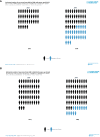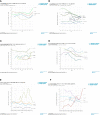Descriptive epidemiology of the head and neck cancers in old patients
- PMID: 37293589
- PMCID: PMC10247222
- DOI: 10.3389/fonc.2023.1102236
Descriptive epidemiology of the head and neck cancers in old patients
Abstract
Background: In Europe, as in other high-income (HI) countries, quite half of the newly diagnosed patients with head and neck (H and N) cancers are older than 65 years of age and their proportion within the prevalent cases is even higher. Moreover, the incidence rate (IR) for all H and N cancers sites increased with age and the survival rate is lower in older patients (≥65), compared with younger patients (<65). The number of older patients affected by H and N cancers will increase because of the increase in life expectancy. The aim of the article is to provide an epidemiological description of H and N cancers in the elderly population.
Material and methods: Incidence and prevalence data by time periods and continents were extracted from the Global Cancer Observatory. The survival information for Europe is obtained from the EUROCARE and RARECAREnet projects. In 2020, according to the results from these data, slightly more than 900,000 cases have been diagnosed with H and N cancers in the world, and approximately 40% were older than 65 years of age. This percentage was higher, reaching approximately 50% in the HI countries. The highest number of cases was in the Asiatic populations, while the highest crude IR was in Europe and Oceania. Among H and N cancers occurring in the elderly, laryngeal and oral cavity cancers were the most common, while nasal cavities and nasopharyngeal cancers were the rarest. This was true for all the countries, excluding some Asiatic populations, in which tumour of the nasopharynx was more common. The five-year survival rate in the European population was low in the elderly, compared with the younger for all H and N cancers, and it ranged from approximately 60% for both salivary-gland type and laryngeal to 22% for hypopharyngeal tumors. For the elderly, the conditional 5-year survival after surviving one year became more than 60% for many H and N epithelial tumors.
Conclusion: The high variability in the H and N cancer incidence around the world is due to the distribution of the major risk factors which for the elderly are mainly alcohol and smoking. The reasons for low survival in the elderly are most likely due to the complexity of treatment, the late arrival of patients at diagnosis, and the difficult access to specialized centers.
Keywords: elderly; epidemiology; head and neck cancer; incidence; population based cancer registries (PBCRs); prevalence; survival; world wide.
Copyright © 2023 Gatta, Capocaccia and Botta.
Conflict of interest statement
The authors declare that the research was conducted in the absence of any commercial or financial relationships that could be construed as a potential conflict of interest.
Figures





References
-
- Muir CS, Fraumeni JF, Jr, Doll R. The interpretation of time trends. Cancer Surveys (1994) 19-20:5–21. - PubMed
-
- Gatta G, Botta L, Sánchez MJ, Anderson LA, Pierannunzio D, Licitra L. EUROCARE working group: prognoses and improvement for head and neck cancers diagnosed in Europe in early 2000s: the EUROCARE-5 population-based study. Eur J Cancer (2015) 51(15):2130–43. doi: 10.1016/j.ejca.2015.07.043 - DOI - PubMed
-
- Orimo H, Ito H, Suzuki T, Araki A, Hosoi T, Sawabe M. Reviewing the definition of “elderly”. Geriatr Gerontol Int (2006) 6:149–158. doi: 10.1111/j.1447-0594.2006.00341.x - DOI
Publication types
LinkOut - more resources
Full Text Sources

